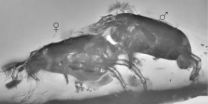(Press-News.org) Same-sex erotic relationships are as old as humanity, but our modern understanding of what it means to be homosexual—and the earliest gay rights movement—started in nineteenth-century Germany, according to an article by historian Robert Beachy from Goucher College.
The article, "The German Invention of Homosexuality," is published in a recent issue of The Journal of Modern History. Beachy's book on the subject, Gay Berlin: Birthplace of a Modern Identity (Knopf), is due out next year.
According to Beachy, modern conceptions of homosexuality began, ironically, with an anti-sodomy law. When the German empire was unified in 1871, the Imperial Criminal Code included a law prohibiting sexual penetration of one man by another. Questions about what types of activity should fall under the law spurred a sustained public inquiry into the nature of same-sex eroticism and sexuality in general.
"As such, [the law] created the all-important context and stimulant for the evolution of the world's most expansive science of homosexuality," Beachy writes. And from that science emerged key components of the modern view of homosexuality, including "the understanding of erotic same-sex attraction as a fundamental element of the individual's biological or psychological makeup," Beachy explains.
This new view of same-sex love was pioneered by German doctors who published early case studies of homosexuals in the 1850s. German psychiatrist Richard von Krafft-Ebing released the first edition of his hugely influential Psychopathia Sexualis in 1886, which included multiple case studies of homosexuals that supported this new position. Through his work, Krafft-Ebing became a vocal opponent of the German anti-sodomy law, stating that homosexuality "should not be viewed as a psychic depravity or even sickness."
A remarkably free German press enabled these ideas to spread outside the scientific literature into popular books and encyclopedias, Beachy says. "The encyclopedia entries suggested directly or implicitly that same-sex eroticism was a naturally occurring if uncommon phenomenon that affected a small percentage of the general population," he writes. "The love that dared not speak its name, as Oscar Wilde put it, had many names, at least in German."
It was also during this time that world's first political organization advocating gay rights, the Scientific-Humanitarian Committee (Wissenschaftlich-humanitäres Komitee, or WhK), was formed. The WhK undertook a massive effort to reform the anti-sodomy law, mailing "enlightenment brochures" to thousands of politicians, religious leaders, doctors, and teachers and collecting thousands of signatures on petitions opposing the law.
The movement ultimately failed to dislodge the law, and German scientific inquiry into sexuality came to an abrupt end with the rise of the Nazis in the 1930s. Nevertheless, Beachy argues, it was that law—and the inquiry and activism it inspired—that helped the modern understanding of homosexuality to take root.
###
Robert Beachy, "The German Invention of Homosexuality." The Journal of Modern History 82:4 (December 2010).
Gay rights movement born in 19th century Germany, scholar says
2011-03-01
ELSE PRESS RELEASES FROM THIS DATE:
New peptide could be effective treatment for triple negative breast cancer
2011-03-01
A new peptide developed by researchers in Temple University's College of Science and Technology has demonstrated efficacy against triple negative breast cancer.
The leptin receptor antagonist peptide, developed by researchers Laszlo Otvos and Eva Surmacz, could become an attractive option for triple negative breast cancer treatment, especially in the obese patient population. The researchers published their findings online in the European Journal of Cancer.
According to the researchers, triple-negative breast cancers—which represent 10 percent of all mammary ...
Development team achieves 1 terabit per second data rate on a single integrated photonic chip
2011-03-01
WASHINGTON, Feb. 28—With worldwide Internet data traffic increasing by 50 percent each year, telecommunications companies that handle this digital torrent must be able to economically expand the capacities of their networks while also adapting to new, more-efficient data-handling technologies. Over the last decade, a development team at Infinera Corp. in Sunnyvale, Calif. has pioneered the design and manufacture of photonic integrated circuits (PICs) aimed at meeting that need. This technology has enabled the team to achieve a record one trillion bits per second (1 Terabit/s) ...
Researchers develop curious snapshot of powerful retinal pigment and its partners
2011-03-01
BETHESDA, Md., Feb. 28, 2011 – Science fiction novelist and scholar Issac Asimov once said, "The most exciting phrase to hear in science, the one that heralds new discoveries, is not 'Eureka!' but 'That's funny.' " This recently rang true for an international team of researchers when they observed something they did not expect.
In a Journal of Biological Chemistry "Paper of the Week," the Berlin-based team reports that it has uncovered surprising new details about a key protein-protein interaction in the retina that contributes to the exquisite sensitivity of vision. ...
Full bladder, better decisions? Controlling your bladder decreases impulsive choices
2011-03-01
What should you do when you really, REALLY have to "go"? Make important life decisions, maybe. Controlling your bladder makes you better at controlling yourself when making decisions about your future, too, according to a study to be published in Psychological Science, a journal of the Association for Psychological Science.
Sexual excitement, hunger, thirst—psychological scientists have found that activation of just one of these bodily desires can actually make people want other, seemingly unrelated, rewards more. Take, for example, a man who finds himself searching ...
MIT-- parts of brain can switch functions
2011-03-01
Cambridge, MASS- When your brain encounters sensory stimuli, such as the scent of your morning coffee or the sound of a honking car, that input gets shuttled to the appropriate brain region for analysis. The coffee aroma goes to the olfactory cortex, while sounds are processed in the auditory cortex.
That division of labor suggests that the brain's structure follows a predetermined, genetic blueprint. However, evidence is mounting that brain regions can take over functions they were not genetically destined to perform. In a landmark 1996 study of people blinded early ...
Gut bacteria can control organ functions
2011-03-01
Bacteria in the human gut may not just be helping digest food but also could be exerting some level of control over the metabolic functions of other organs, like the liver, according to research published this week in the online journal mBio®. These findings offer new understanding of the symbiotic relationship between humans and their gut microbes and how changes to the microbiota can impact overall health.
"The gut microbiota enhances the host's metabolic capacity for processing nutrients and drugs and modulates the activities of multiple pathways in a variety of organ ...
Mating mites trapped in amber reveal sex role reversal
2011-03-01
ANN ARBOR, Mich.---In the mating game, some female mites are mightier than their mates, new research at the University of Michigan and the Russian Academy of Sciences suggests. The evidence comes, in part, from 40 million-year-old mating mites preserved in Baltic amber.
In a paper published March 1 in the Biological Journal of the Linnean Society, researchers Pavel Klimov and Ekaterina Sidorchuk describe an extinct mite species in which the traditional sex roles were reversed.
"In this species, it is the female who has partial or complete control of mating," said Klimov, ...
Dry lake reveals evidence of southwestern 'megadroughts'
2011-03-01
LOS ALAMOS, New Mexico, February 28, 2011—There's an old saying that if you don't like the weather in New Mexico, wait five minutes. Maybe it should be amended to 10,000 years, according to new research.
In a letter published recently in the journal Nature, Los Alamos National Laboratory researchers and an international team of scientists report that the Southwest region of the United States undergoes "megadroughts"—warmer, more arid periods lasting hundreds of years or longer. More significantly, a portion of the research indicates that an ancient period of warming may ...
Silk moth's antenna inspires new nanotech tool with applications in Alzheimer's research
2011-03-01
ANN ARBOR, Mich.---By mimicking the structure of the silk moth's antenna, University of Michigan researchers led the development of a better nanopore---a tiny tunnel-shaped tool that could advance understanding of a class of neurodegenerative diseases that includes Alzheimer's.
A paper on the work is newly published online in Nature Nanotechnology. This project is headed by Michael Mayer, an associate professor in the U-M departments of Biomedical Engineering and Chemical Engineering. Also collaborating are Jerry Yang, an associate professor at the University of California, ...
Neighborhood barbers can influence black men to seek blood-pressure treatment
2011-03-01
DALLAS – March 1, 2011 – Will Marshall saw a physician about his blood pressure at his barber's urging.
Yes, his barber.
"The barber and beauty shops for men and women are kind of their own private escapes," Mr. Marshall said. "Every conversation you can imagine goes on in the barbershop. I wouldn't have put the barbershop and blood pressure together – but that visit to my physician for my blood pressure saved my life."
Mr. Marshall now has a healthy blood pressure thanks to lifestyle and dietary changes.
He is one of about 1,300 participants in a study described ...


